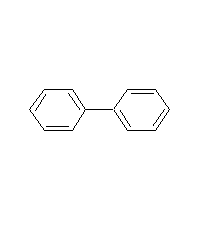
structural formula
| business number | 024t |
|---|---|
| molecular formula | c12h10 |
| molecular weight | 154.21 |
| label |
phenylbenzene, biphenyl, 1,1′-biphenyl, bibenzene,biphenyl, phenylbenzene, fungicides, aromatic compounds |
numbering system
cas number:92-52-4
mdl number:mfcd00003054
einecs number:202-163-5
rtecs number:du8050000
brn number:1634058
pubchem number:24861956
physical property data
1. characteristics: white to light yellow flaky crystals, with a sharp odor and a rose-like aroma after dilution.
2. boiling point (ºc, 101.3kpa): 255.2
3. melting point (ºc): 69
4. relative density (g/ml, 20 /4ºc): 1.04
5. refractive index (n77d): 1.588
6. kinematic viscosity (m2/s, 100ºc): 0.98×10-6
7. flash point (ºc, closed): 113
8. ignition point (ºc): 540
9. heat of evaporation (kj/kg, 200ºc): 343.3
10. heat of fusion (kj/ mol, 70.5ºc): 18.59
11. heat of formation (kj/mol, solid): 96.67
12. heat of combustion (kj/mol): 6252.4
13. specific heat capacity (kj/(kg·k), constant pressure): 1.61
14. critical temperature (ºc): 515.7
15. critical pressure (mpa): 3.38
16. thermal conductivity (w/(m·k), 100ºc): 1339.77
17. lower explosion limit (%, v/v): 0.6
18. explosion upper limit (%, v/v): 5.8
19. solubility: insoluble in water, soluble in ether, ethanol, carbon tetrachloride, dioxane, aromatic hydrocarbons, etc. . dissolves 9.1% in ethanol at 19.5°c.
20. critical pressure (mpa): 3.38
21. critical density (g·cm-3): 0.310
22. critical volume (cm3·mol-1): 497
23. critical compression factor: 0.262
24 . eccentricity factor: 0.366
25. solubility parameter (j·cm-3)0.5: 19.383
26. van der waals area (cm2·mol-1): 1.066×1010
27. van der waals volume (cm3·mol-1): 91.680
28. gas phase standard heat of combustion (enthalpy) (kj·mol-1 ):-6332.7
29. gas phaseagent, heat transfer agent, fruit antifungal agent, organic synthesis.
2. biphenyl has high thermal stability and low vapor pressure. it has long been used as a heat transfer medium alone or mixed with diphenyl ether. santos wax composed of biphenyl, terphenyl, etc. (containing 13% biphenyl and 61% terphenyl) can effectively absorb radiation and can be used as a heat carrier in nuclear power plants. terphenyl ([91-94-4]) happens to be a by-product of the thermal decomposition of benzene to produce biphenyl. depending on the reaction conditions, the ratio of biphenyl and terphenyl in the reaction product changes within a certain range. under normal circumstances , biphenyl:terphenyl=7-8:1. biphenyl is also used as a dyeing carrier, and its derivatives ethylbiphenyl, diethylbiphenyl, and triethylbiphenyl can be used as advanced solvents for dye solvents in pressure-sensitive copy paper. para-phenylphenol derived from biphenyl is also mainly used to make resins. it is used as a microcapsule material for developer and coupler in the production of pressure-sensitive copy paper, and can also be used to make special coatings. biphenyl is used as an impregnating agent for citrus wrappers and as a treatment for certain diseases of citrus plants. chlorinated biphenyl is a plasticizer for chlorinated rubber and vinyl polymers.
3.used in the preparation of pressure-sensitive copy paper, special coatings and other organic synthesis. used as heat transfer agent. chromatographic analysis reference substances and fruit fungicides.
4. a small amount is used in daily flavors and food flavors, often used as heat exchange agents and intermediates in organic synthesis.
5. this product is a better organic heat carrier and a raw material for making high-quality insulating liquids; it is used as a plasticizer and preservative, and is also used in the manufacture of dyes, engineering plastics, high-energy fuels, and anti-corrosive materials. 4-phenylbenzophenone, the intermediate of fungal medicine, etc.

 微信扫一扫打赏
微信扫一扫打赏

